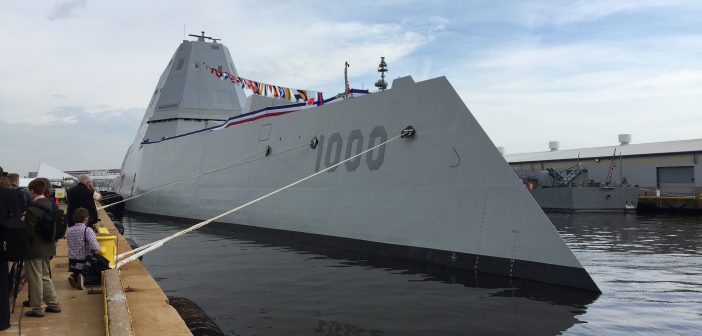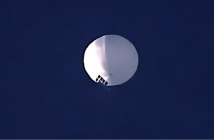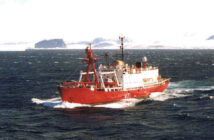The USS Zumwalt, commissioned over the weekend in Baltimore, is a revolutionary step forward for the US Navy in terms of stealth, ship systems and firepower that will shape future warships.
For that to happen, the Navy must keep investing in the class — rightly seen as a key transitional step to the future — while using them as operational units and developmental test beds for new systems and weapons.
An all-electric ship that uses extensive automation for ship systems, firefighting and damage control to reduce crew size, the 15,700-ton ship Zumwalt is more than 60 percent larger than a 9,500-ton Burke-class destroyer, but manned by 175 instead of more than 300 sailors.
An Integrated Power System promises great efficiency and flexibility with less maintenance than current ships with their hydraulic, pneumatic and other systems.
Unlike current cruisers and destroyers that use one set of gas turbines for propulsion and a second, separate set to generate shipboard electrical power, Zumwalt uses a single set of turbines to generate enormous electrical power for both purposes – 78 megawatts, enough to power a small city – to turn giant electric motors that propel ship and run other systems.
While cruising at a speedy 20 knots, the ship only uses 20 megawatts, leaving 58 megawatts for sensors, weapons and other needs. That abundance of power means the ship could operate electromagnetic rail guns and high-power lasers, both of which are now under development.
Zumwalt also has unprecedented stealth for a large warship with a radar signature that is 50 times less than a Burke-class destroyer, which in turn was 50 times more stealthy than a Ticonderoga-class cruiser.
That signature reduction extends underwater as well where the ship is also far quieter than others in its class.
She also has greater firepower than other cruisers and destroyers, including two six-inch guns that can fire precision, rocket-assisted rounds at targets at ranges of more than 60 miles, and 80 large missile tubes that can accommodate more powerful, longer-range future weapons.
A giant flight deck is another attribute that opens a vast range of future operational possibilities.
It’s only fitting that a ship bristling with so much innovation – from the Navy and a vast industry team that includes shipbuilder Bath Iron Works, Raytheon, DRS Technologies, Huntington Ingalls Industries and many more – is named for an extraordinarily innovative leader who is the father of the modern US Navy.
The youngest chief of naval operations in history, Adm. Elmo “Bud” Zumwalt, was a combat leader who saw action in World War II and Korea before leading naval forces in Vietnam.
But it was his tenure as CNO during which he aggressively transformed the Navy on all fronts at the very height of the Cold War. He fought to make the Navy a more just institution, righting ingrained racism that by the 1960s were the source of bloody shipboard riots. He opened billets for women and also drove investment in leap-ahead aircraft, subs, command systems and weapons.
The Zumwalt class was to have been a tribute to a visionary leader. Rarely has the Navy packed so much all-new technology into a new class of ships — a new generation radar and power system, electric propulsion and other systems, new sonar, a lightweight composite deckhouse, new guns and missile tubes and features like longer-lasting components that were more costly upfront but reduced through-life costs.
But all that innovation was expensive. Zumwalt was to have been the first of a 32-ship class to replace the existing Burke-class, but the program was capped at just three vessels, in part because unit procurement cost was deemed too high.
Another big question was core mission of the ships – to serve as modern-day battleships tailored to supporting ground forces relatively near the shore – at a time when the fleet needed more robust air and missile defenses. While the Zumwalts could have been adapted for the mission, the decision was made to resume production of the Burke-class and develop a new version – the Flight III model – with even more potent air and missile defense capabilities.
Although Zumwalt has been commissioned, it will take more than a year for the ship to be ready to get underway for its first deployment. So much about the ship is so new, there are many bugs left to be worked out.
Still, even at three ships, the Zumwalts will be important additions to the fleet.
Their stealth and firepower will be welcome, especially in the Pacific and they will demonstrate the bounds of novel technology, especially whether all-electric ships with such extensive automation and small crews will prove operationally successful.
Now, the Navy must start using Zumwalt and her sisters extensively. These ships are different from anything else in the fleet and the more they are used, the more quickly problems will be resolved and operational, tactical and engineering lessons learned.
Having spent $12 billion on three ships, there will be natural reluctance to spend even more on them. But the Navy must continue investing in these ships to equip them with ballistic missile defense capabilities and even better self-protection than they already have. USS Mason has been attacked three times by missiles launched from Yemen and while the Navy won’t disclose how the ship protected itself, layered defenses remain critical.
Investment will also be critical to help develop and operationally test new systems and weapons for existing and future ships.
As with any new ship, the commissioning is just the start. What is clear is that this ship and its sisters will carry forward the spirit of boldness, innovation and courage that characterized Adm. Zumwalt and the Navy that he helped forge.




